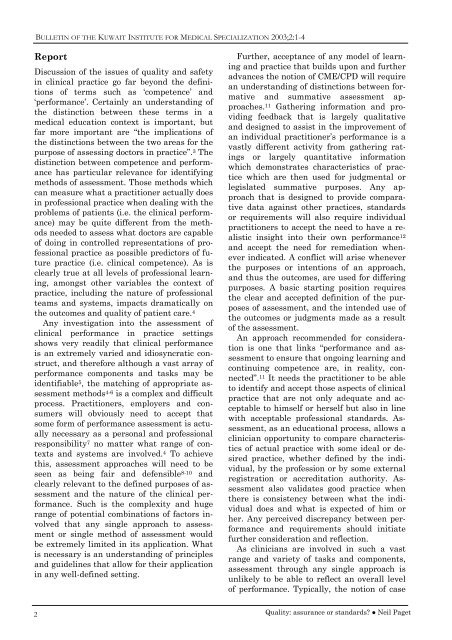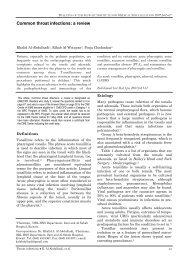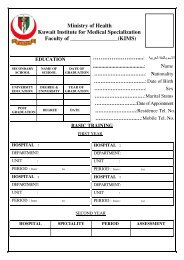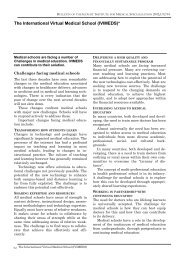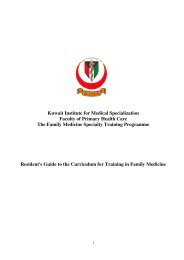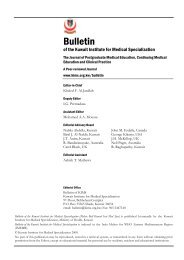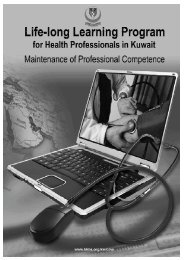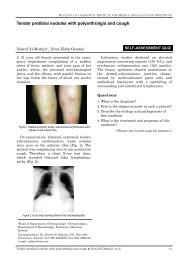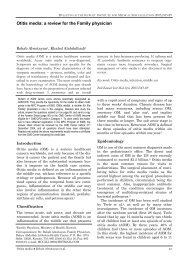Quality: assurance or standards? - Kuwait Institute for Medical ...
Quality: assurance or standards? - Kuwait Institute for Medical ...
Quality: assurance or standards? - Kuwait Institute for Medical ...
You also want an ePaper? Increase the reach of your titles
YUMPU automatically turns print PDFs into web optimized ePapers that Google loves.
BULLETIN OF THE KUWAIT INSTITUTE FOR MEDICAL SPECIALIZATION 2003;2:1-4Rep<strong>or</strong>tDiscussion of the issues of quality and safetyin clinical practice go far beyond the definitionsof terms such as ‘competence’ and‘perf<strong>or</strong>mance’. Certainly an understanding ofthe distinction between these terms in amedical education context is imp<strong>or</strong>tant, butfar m<strong>or</strong>e imp<strong>or</strong>tant are “the implications ofthe distinctions between the two areas f<strong>or</strong> thepurpose of assessing doct<strong>or</strong>s in practice”. 3 Thedistinction between competence and perf<strong>or</strong>mancehas particular relevance f<strong>or</strong> identifyingmethods of assessment. Those methods whichcan measure what a practitioner actually doesin professional practice when dealing with theproblems of patients (i.e. the clinical perf<strong>or</strong>mance)may be quite different from the methodsneeded to assess what doct<strong>or</strong>s are capableof doing in controlled representations of professionalpractice as possible predict<strong>or</strong>s of futurepractice (i.e. clinical competence). As isclearly true at all levels of professional learning,amongst other variables the context ofpractice, including the nature of professionalteams and systems, impacts dramatically onthe outcomes and quality of patient care. 4Any investigation into the assessment ofclinical perf<strong>or</strong>mance in practice settingsshows very readily that clinical perf<strong>or</strong>manceis an extremely varied and idiosyncratic construct,and theref<strong>or</strong>e although a vast array ofperf<strong>or</strong>mance components and tasks may beidentifiable 5 , the matching of appropriate assessmentmethods 4-6 is a complex and difficultprocess. Practitioners, employers and consumerswill obviously need to accept thatsome f<strong>or</strong>m of perf<strong>or</strong>mance assessment is actuallynecessary as a personal and professionalresponsibility 7 no matter what range of contextsand systems are involved. 4 To achievethis, assessment approaches will need to beseen as being fair and defensible 8-10 andclearly relevant to the defined purposes of assessmentand the nature of the clinical perf<strong>or</strong>mance.Such is the complexity and hugerange of potential combinations of fact<strong>or</strong>s involvedthat any single approach to assessment<strong>or</strong> single method of assessment wouldbe extremely limited in its application. Whatis necessary is an understanding of principlesand guidelines that allow f<strong>or</strong> their applicationin any well-defined setting.Further, acceptance of any model of learningand practice that builds upon and furtheradvances the notion of CME/CPD will requirean understanding of distinctions between f<strong>or</strong>mativeand summative assessment approaches.11 Gathering inf<strong>or</strong>mation and providingfeedback that is largely qualitativeand designed to assist in the improvement ofan individual practitioner’s perf<strong>or</strong>mance is avastly different activity from gathering ratings<strong>or</strong> largely quantitative inf<strong>or</strong>mationwhich demonstrates characteristics of practicewhich are then used f<strong>or</strong> judgmental <strong>or</strong>legislated summative purposes. Any approachthat is designed to provide comparativedata against other practices, <strong>standards</strong><strong>or</strong> requirements will also require individualpractitioners to accept the need to have a realisticinsight into their own perf<strong>or</strong>mance 12and accept the need f<strong>or</strong> remediation wheneverindicated. A conflict will arise wheneverthe purposes <strong>or</strong> intentions of an approach,and thus the outcomes, are used f<strong>or</strong> differingpurposes. A basic starting position requiresthe clear and accepted definition of the purposesof assessment, and the intended use ofthe outcomes <strong>or</strong> judgments made as a resultof the assessment.An approach recommended f<strong>or</strong> considerationis one that links “perf<strong>or</strong>mance and assessmentto ensure that ongoing learning andcontinuing competence are, in reality, connected”.11 It needs the practitioner to be ableto identify and accept those aspects of clinicalpractice that are not only adequate and acceptableto himself <strong>or</strong> herself but also in linewith acceptable professional <strong>standards</strong>. Assessment,as an educational process, allows aclinician opp<strong>or</strong>tunity to compare characteristicsof actual practice with some ideal <strong>or</strong> desiredpractice, whether defined by the individual,by the profession <strong>or</strong> by some externalregistration <strong>or</strong> accreditation auth<strong>or</strong>ity. Assessmentalso validates good practice whenthere is consistency between what the individualdoes and what is expected of him <strong>or</strong>her. Any perceived discrepancy between perf<strong>or</strong>manceand requirements should initiatefurther consideration and reflection.As clinicians are involved in such a vastrange and variety of tasks and components,assessment through any single approach isunlikely to be able to reflect an overall levelof perf<strong>or</strong>mance. Typically, the notion of case2<strong>Quality</strong>: <strong>assurance</strong> <strong>or</strong> <strong>standards</strong>? ● Neil Paget


